

Your life, if born a calf on a beef farm
Cow-calf stage of beef production (0-8 months of age)
You are probably born at night and with little difficulty, but if your mother has trouble delivering you then your first contact outside her womb may be in the arms of the rancher, as she helps deliver you safely, with little harm to you or your mother. As the sun rises you see the world for the first time, and one of these sights is the rancher’s truck coming your way. Your mother does not run from the truck, as it is delivering food, so you do not run either. As your mother begins munching on the grain the rancher quickly catches you, places an ear tag in your ear, coats your navel with iodine, and then releases you. This tag contains a number, which is basically your name, allowing the farmer to record your mother’s identity and to also track your progress. Before releasing you, some ranchers may place a pellet under the skin of your ear, which slowly release a synthetic growth hormone that will help you grow fast, reducing costs for the rancher and the amount of resources consumed for each lb of meat you produce.(S2) Not all farms use the hormones though; it depends on its price and the expected weight gain the rancher believes it provides.
Figure 1—Cow and her calf
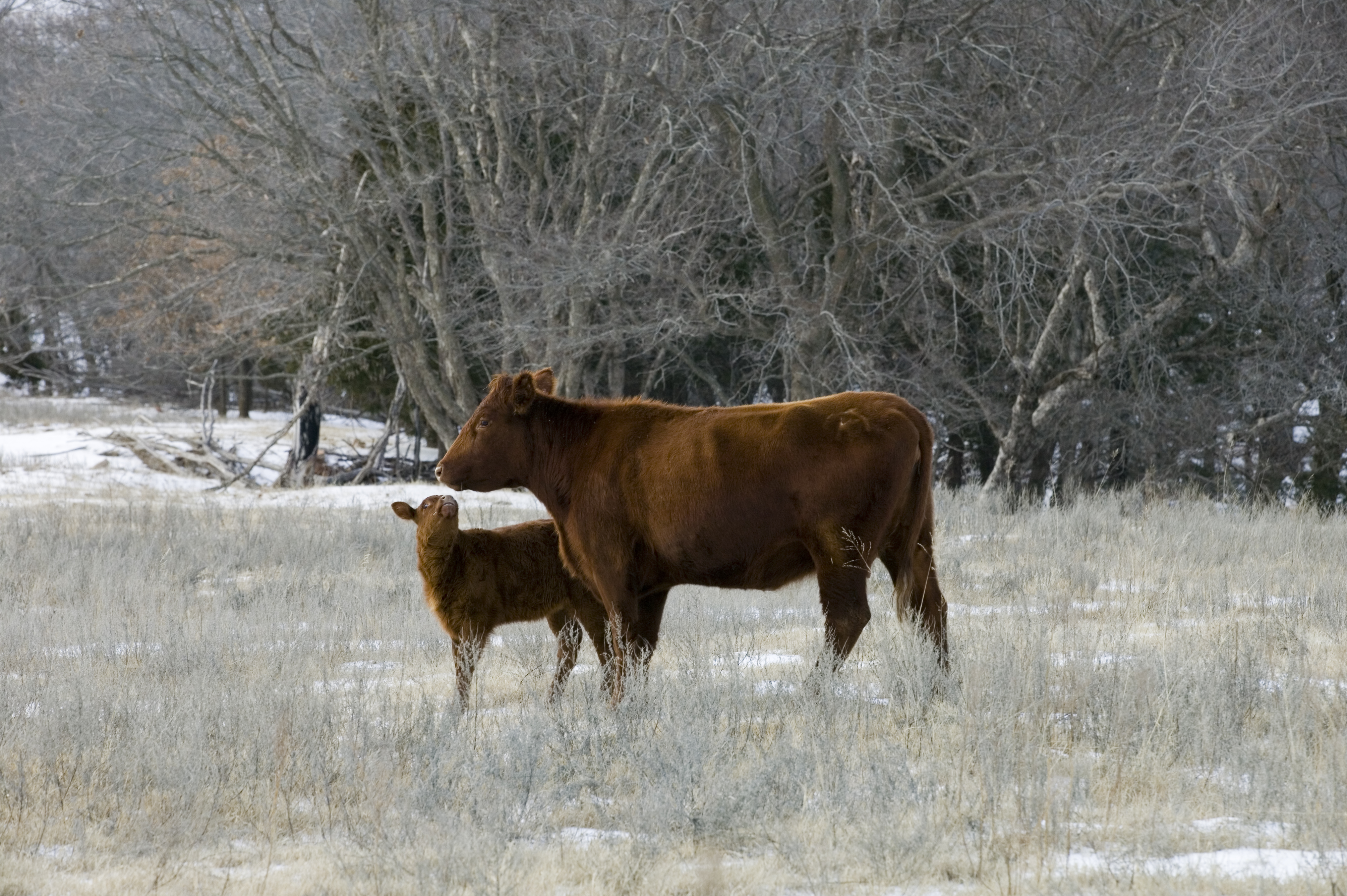
For the next month you will never be touched by a human hand. In fact, except for a few times in the next 8 months of your life you will be left alone in a large pasture, living what most would call a natural life (natural except that you have little need to fear predators). When you are handled it is to vaccinate you against several viruses and to pour liquid on your back, which wards off flies and various parasites.
Some ranchers may castrate males on the day they are born, cutting a whole in the scrotum sack and pulling the testicles out with their hands—for one semester as an undergraduate this was my job, and yes, it takes some getting used to! Many farms will wait until you are a month or two old, and will place a tight band (think of a small but strong rubber band) above your scrotum sack and below your belly. Cutting off circulation to your testicles, the band causes the scrotum and its testes to die and fall off your body. A third method is the burdizzo, which crushes the cords above the testicles.
What is important is that you castration not be postponed until you are many months old. The procedure is more bloody, more painful, and more likely to result in infection. If you are not castrated you provide inferior meat and are more likely to injure ranchers and other cows. Anaesthetic could, but rarely is, used on working farms.
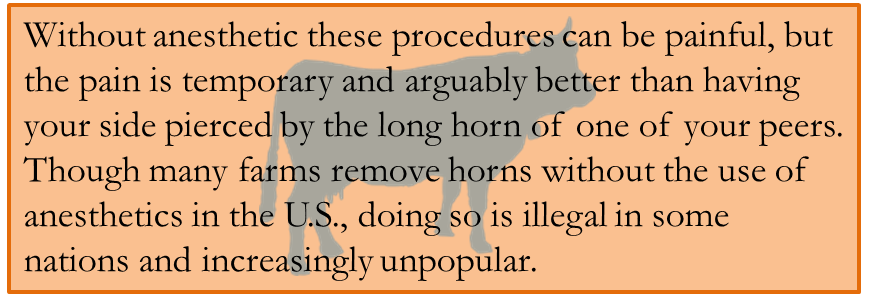
Not all breeds of cattle grow horns. The Angus and Polled Hereford breeds, for example, do not. If you are one of the breeds who naturally grow horns they will probably be removed to prevent you from hurting yourself, other cows, or humans. Most dairy cows are naturally horned, and since most of the male dairy calves are used for milk production they will have to be dehorned before they become large enough to cause injury. This can be achieved by rubbing a paste on the buds of your horns. The paste probably contains calcium hydroxide and sodium hydroxide, chemicals that work by burning and thus destroying the cells that produce horns. Or, you may be dehorned using other methods, like burning the horn buds with a hot iron, or using an implement that simply “scoops”the horn and its root out of the head. Without anaesthetic these procedures can be painful, but the pain is temporary and arguably better than having your side pierced by the long horn of one of your peers. Though many farms remove horns without the use of anaesthetics in the U.S., doing so is illegal in some nations and increasingly unpopular.
It will likely be cold the day you are born, perhaps in late February or early March. It may strike you as odd that every other calf is about your age. Indeed, every mother cow conceived at about the same time because they were brought to estrus simultaneously. Ranchers synchronize estrus by inserting a small device in the cow’s vagina, a device referred to as a CIDR, which resembles a tampon. The CIDR will remain in the vagina for seven days. On the sixth day an injection of prostaglandin is administered and on the seventh day the CIDR is removed. The cow will then go into ’heat“ (i.e., estrus) eight to eleven days after the CIDR is inserted (and one to three days after it is removed).(R1)
Not all ranchers synchronize estrus. Some may instead observe the cattle and simply breed them whenever they naturally come into heat. There are a number of different ways of detecting which cows are in heat. Most livestock seem to exhibit some degree of homosexuality, and when a cow is in estrus other female cows will often try and mount her as if they are going to breed her, thereby revealing to the rancher the cow is indeed in heat. A similar method is to take a cow not needed for breeding and inject her with testosterone (a male hormone) so that she behaves like a male. This testosterone-pumped female will then try and mount every cow in heat.
I once had a job where I rode a horse and penned a herd of cattle in the corner of a pasture. Then for fifteen minutes I watched this hormone-altered female as she tried to mount others cow in heat, and would then write down the identification number of the cows being mounted (a cow in estrus will also want to mount other cows). The next day someone would artificially inseminate the cows on that list. Other ranchers attach a device to head of the hormone-altered female (or steer) with something resembling a ball-point pen on the bottom. Then, whenever she mounts another cow, as the bottom of her head rubs against the cow’s back it releases ink. The rancher can then identify cattle in heat according to whether their backs are painted, and breed them soon after.
Many other methods of heat detection exists. Simply observing regular cows mounting one another can be surprisingly effective. After receiving a vasectomy, bulls are sometimes used. Or, devices can be taped onto the rear portion of a cow’s backbone, and if she is mounted enough it will change color.
Not all farms use such advanced breeding technology.(O2) Some just release a bull into a herd of cattle and allow them to breed naturally.
Now, back to your life. It may seem odd that you are born at a time when there is little grass to eat, but the reason becomes obvious in a few months. Though you will nurse for perhaps eight months you will begin supplementing milk with grass when only a few weeks old. By June and July you are growing fast, constantly nursing and grazing, and your mother needs as much nourishment as possible to produce your milk. June and July also happens to be the time when grass (the cheapest feed) is most available. You were born in late winter so that grass is most abundant when it is most needed.
To help meet all your nutritional needs there is always a mineral block (or bowl of ground minerals) in the pasture, something you feel the urge to lick periodically. This helps ensure you have all your mineral needs met, but it might also contains some antibiotics which helps you stay healthy and grow fast. Water will always be available in the form of a trough fed by groundwater or a “tank” (a small pond).
When noticing that all other calves are roughly your age, what you do not recognize was that there is a smaller herd of cows you never encounter. Calves in this herd were born in the early fall, and thus needed food the most when it was cold and no grass grew. Around the time you were born these calves were being weaned and sent to the market for sale. Because there was no grass, the rancher provided these calves forage in the form of hay, so they had plenty to eat. Feeding hay is more expensive than grazing grass, and thus these fall-born calves are more expensive to raise. The higher expense discourages ranchers from calving in the fall, but because there are fewer weaned calves on the market in March, the rancher receives a higher price. Thus, some producers are willing to incur the higher cost of calving in the fall because those calves will receive a higher price. Markets thus coordinate ranchers’ calving such that there are weaned calves at almost all times of the year, and thus there is a year-round supply of fresh beef.
Figure 2—Cattle eating hay

Back to your life, and the life of other calves your age. Only very rarely are you confined to small spaces. Most of the time you live in a large pasture with other calves and their mothers. You will not be confined to a barn unless you are very sick, and once the grass starts growing it does so in ample quantities. Life feels natural, like this is the way you were supposed to live. Your mother by your side always, peers to play with, and new pastures to explore, you cannot imagine anything else you could possibly want.
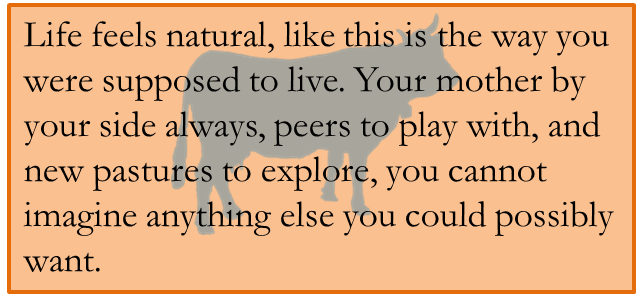
By October you are more mature and independent. Your time on the cow-calf operation is almost complete, but you must be weaned before you are sold to another rancher. Being weaned is stressful. Your mother is taken to the other side of the farm, and as you call and call for her she does not answer. The anxiety doesn’t last long, though. To help you through this stressful time the rancher may supplement your forage (grass and hay) with a grain supplement, and the second you look sick health care is provided, usually in the form of antibiotics. Some ranchers anticipate health problems at weaning, and in response add low levels of antibiotics to your feed. At birth you weighed around 80 lbs, but now you weigh 500. Two weeks after being weaned, it is now time for the second stage of your life, and the second stage of beef production.
Before going to the second stage of your life, let’s pause and consider what your life would have been like if you had been born a heifer, which is what females are called before they have their first calf. If the rancher decides to keep a heifer for breeding purposes, the only time she will leave the farm is right at the end of her life. Until then, she stays on the farm and is kept in a pasture with other heifers until about fifteen months old, after which she is bred for the first time. The gestation period for cows is nine months, so this will have her calving at about two years of age, in late winter. Some ranchers may simply place a bull in the pasture for natural breeding, but others may use artificially insemination (AI). Heifers have more trouble calving due to their smaller bodies, so ranchers may use bull semen from sires known to produce smaller calves. The rancher will also keep a closer eye on heifers than the older cows.
After a month passes a rancher may use ultrasound to detect if she is pregnant, and if not, will either sell her for slaughter or breed her again. After she gives birth the heifer becomes a cow, and will be placed in a herd, and there she will continue to produce calves for two to five years—or perhaps even up to ten years, depending on her reproductive performance and ability to provide milk. There will come an age when she is less productive than younger heifers, and the farmer will sell her for slaughter. After being sold in an auction she is transported and held in pens for a few days, after which her muscle, though too tough for use as steaks, will be made into a processed meat like ground beef or sausage.
Remember, you are not this hypothetical heifer. You are a steer, and it is now time to introduce you to your second stage in life. If you had been born a heifer that the rancher decided not to retain for breeding, your life would have been the same as being born a male.(B6,N3)
Stocker stage of beef production (8-12 months of age)
After being taken to an auction and sold to a new owner, you are placed into a group of strangers of roughly the same size and age. For a few days you are held in small pens, and then transported in a cramped trailer to your new home. There you are again held temporarily in pens, and perhaps another synthetic growth hormone will be placed under the skin of your ear. Just to be safe you might be administered some antibiotics in your feed, but only a short time passes until you are once again released into a large pasture.(A1,S2) It’s not exactly the home you once knew, but very close to it.
Figure 3—Stocker cattle grazing on young wheat
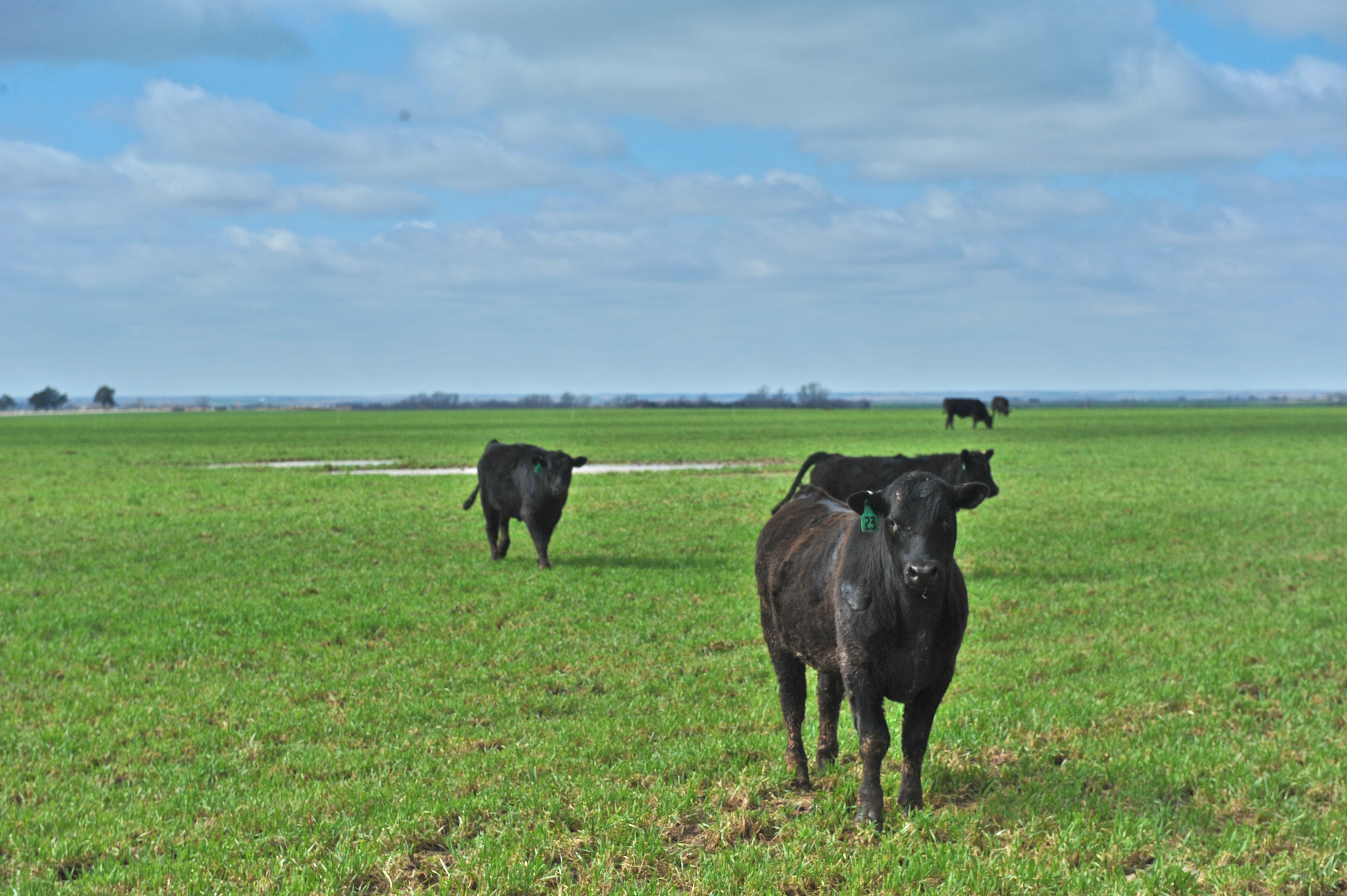
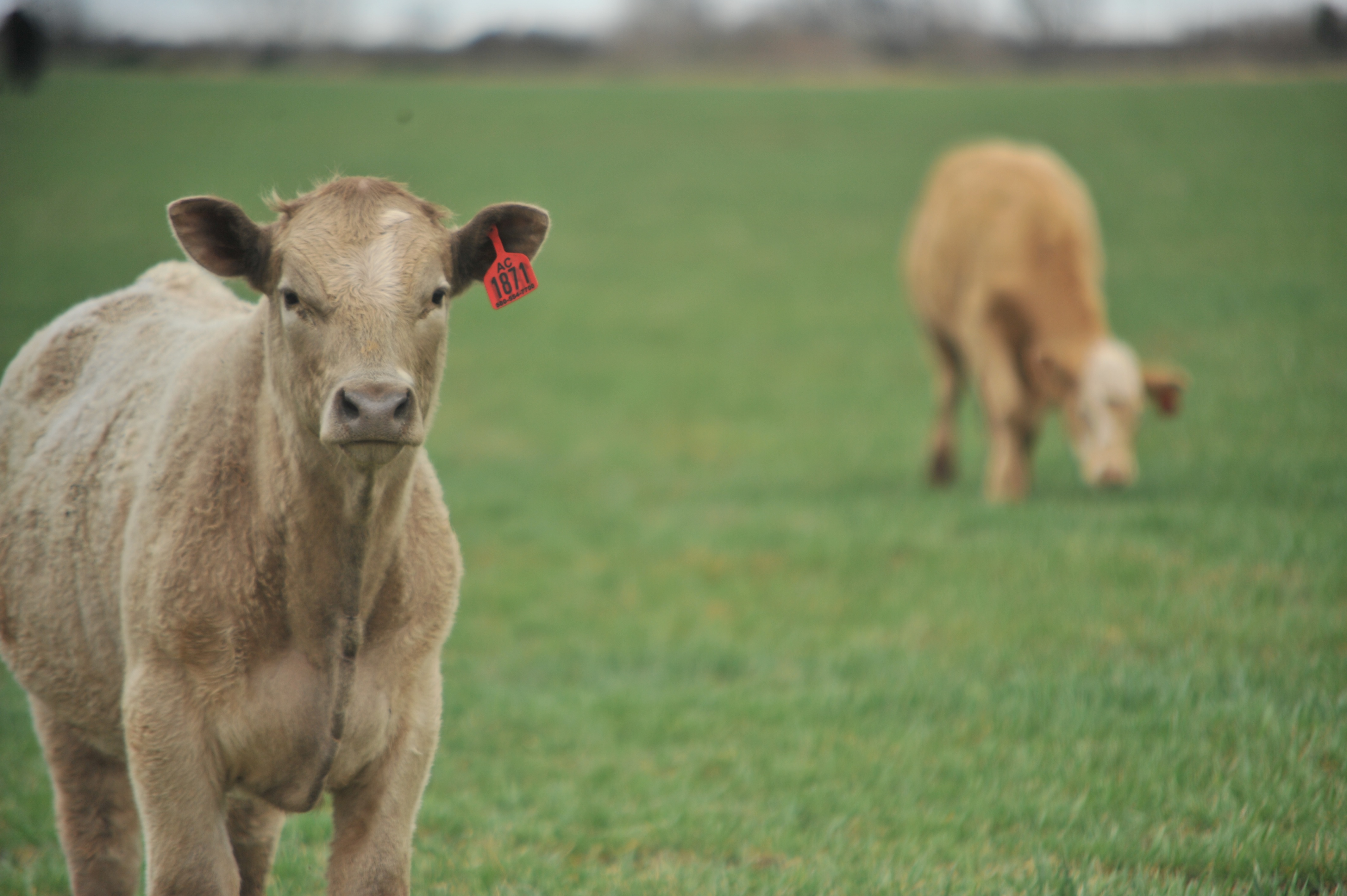
Now you are a stocker calf, and the first thing you notice is that the grass tastes different. You have tasted wheat for the first time. The farmer grew wheat for two reasons: to feed cattle and to harvest wheat for sale. However, she can only both if you and your friends are removed from the wheat before the wheat develops its “first hollow stem”. This is when an ungrazed wheat plant begins growing a hollow stem just above the level of the plant roots and has reached a length of one-inch (so the farmer must make sure there are some wheat plants that are not grazed). If wheat prices are low and the price of cattle high, the farmer may decide to let you continue grazing wheat after the first hollow stem, forgoing the sale of wheat so that she can sell you at a higher weight.(H1,T1)
This is your story of the stocker stage of production if you were raised in the south-central U.S. In other places you might be fed hay and grain during the winter, or perhaps grazed on winter wheat planted exclusively for grazing (and thus will not be harvested for wheat seed). Some farmers may use fescue or clover, which provide grazing in fall and/or spring.
Figure 4—First hollow stem of wheat
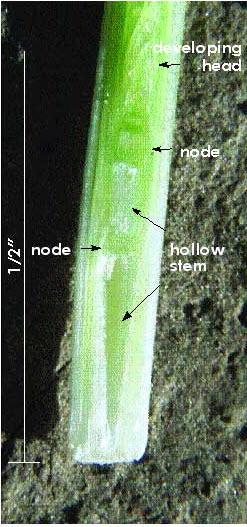
Finishing stage of beef production (12-18 months of age)
Your days of pasture are over. After being sold in an auction you are loaded on a large trailer and transported to your third home, referred to as a feedlot. Upon arrival, the first thing you notice is the complete lack of grass. The air is dry, much drier than your former two homes. The feedlot industry has deliberately moved to the south-central U.S. where the climate is generally pleasant and dry. With little rain the pens in which you live remain dry, and the arid climate helps promote cattle health. It is dusty at times, and you are constantly pestered by flies, but may be preferable to the damp cold. For perhaps the third time in your life a synthetic growth hormone may be inserted under the skin of your ear.
Figure 5—Feedlot
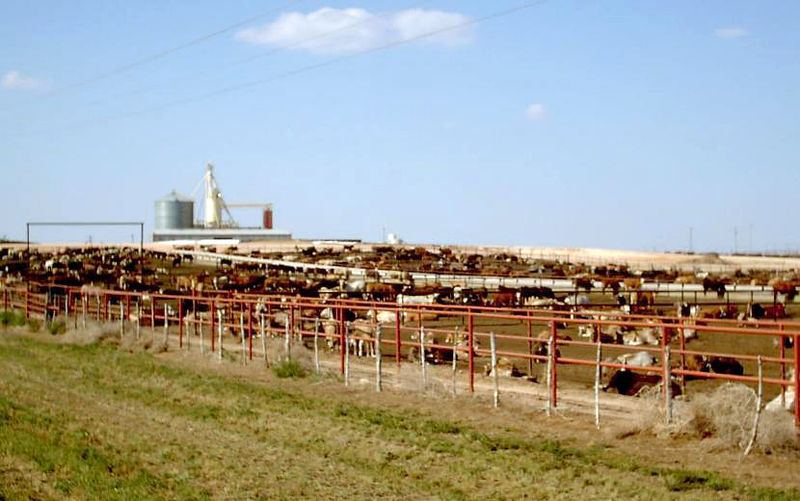
Though the pen that is your new home is not large, the animals are not nearly as cramped as in hog or broiler facilities. There is roughly 250 square feet of space per animal, ten times the amount provided to a hog. There is no shelter from bad weather, not even a shade for the summer heat, so you envy the pigs and broilers in that regard. Most every step you take is atop the urine and feces of other cattle, but because it is so dry at the feedlot the ground feels more like regular dirt than manure. Though you have greater space than hogs or chickens this is partly because you are outside, not in a barn. The pens are designed with a small hill in the center, so that when it rains the water flows away from the center and towards the back and sides of the pen. In these times only part of the lot is dry, so the greater space requirements were not provided out of kindness to you, but in recognizing that in bad weather some of the pen will be too wet to lie and rest.
The absence of grass concerns you at first, until you are given the most delicious feed imaginable. Only rarely in the past were you given corn, soybean meal, or silage, but now it is available in large portions—and you absolutely love it. If given the choice between this feed and grass, you’ll take the feedlot ration every time. I know this because I have observed dairy cattle who have access to both a feed similar to the feedlot diet and grass. The cows will eat some grass, but will strongly prefer the feed, and will instead use the grass largely for dry, comfortable resting places.(N3)
The feedlot diet is so different than forage—your normal food—that you must be slowly transitioned to it. If put on a high-grain diet immediately the shock of the new feed will cause bloating and/or acidosis (which can kill all the bacteria in the digestive system) and could very well kill you. When first arriving at the feedlot the feed you are given contains high amounts of forage and little grain, but over time the forage content falls and the grain content rises. It is in the feedlot’s interest to keep you alive, and the science of beef cattle nutrition has been almost perfected. As a result, less than 2% of the feedlot cattle experience bloating, and the mortality rate due to the feedlot diet is only around 0.05%.
Unlike chickens and hogs, cows rarely fight amongst each other, so injuries are seldom. If anyone in your pen gets hurt it is mostly likely due to riding, where steers mount one another as if they are going to breed. This is pointless, as you are a steer, and your pen-mates are all steers. There are other pens consisting of heifers who were not reserved for breeding, and so their life is nearly identical to yours. Riding is even a problem with the heifers. However, riding is easy to detect, and cattle identified as frequent riders are removed and kept separate from others.(N3)
Though you cannot taste it, at first, your food at the feedlot will sometimes have low levels of antibiotics, even when you are not sick. These “subtherapeutic” antibiotics administered to you reduces sickness, reduces the mortality rate, and helps you grow faster. They can also prevent liver infections, which arises when cattle are eating large amounts of grain and are growing fast. At some point close to slaughter the antibiotics will be removed from your food, to make sure there are no antibiotics residues in the meat that you provide.(A1)
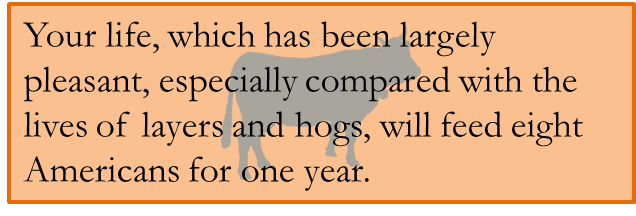
Months have passed. Though you miss pastures you also do not wish to stray too far from the feeding trough, where that scrumptious meal is delivered. At 16 months of age, and around 1,300 lbs, you are sold for slaughter, where your meat is made into steaks, briskets, ground beef, roasts, and the like.
Your life, which has been largely pleasant, especially compared with the lives of layers and hogs, will feed eight Americans for one year.(E1,H1,N1,N2,N3,S1,T1)
Figure 6—Three stages of beef production
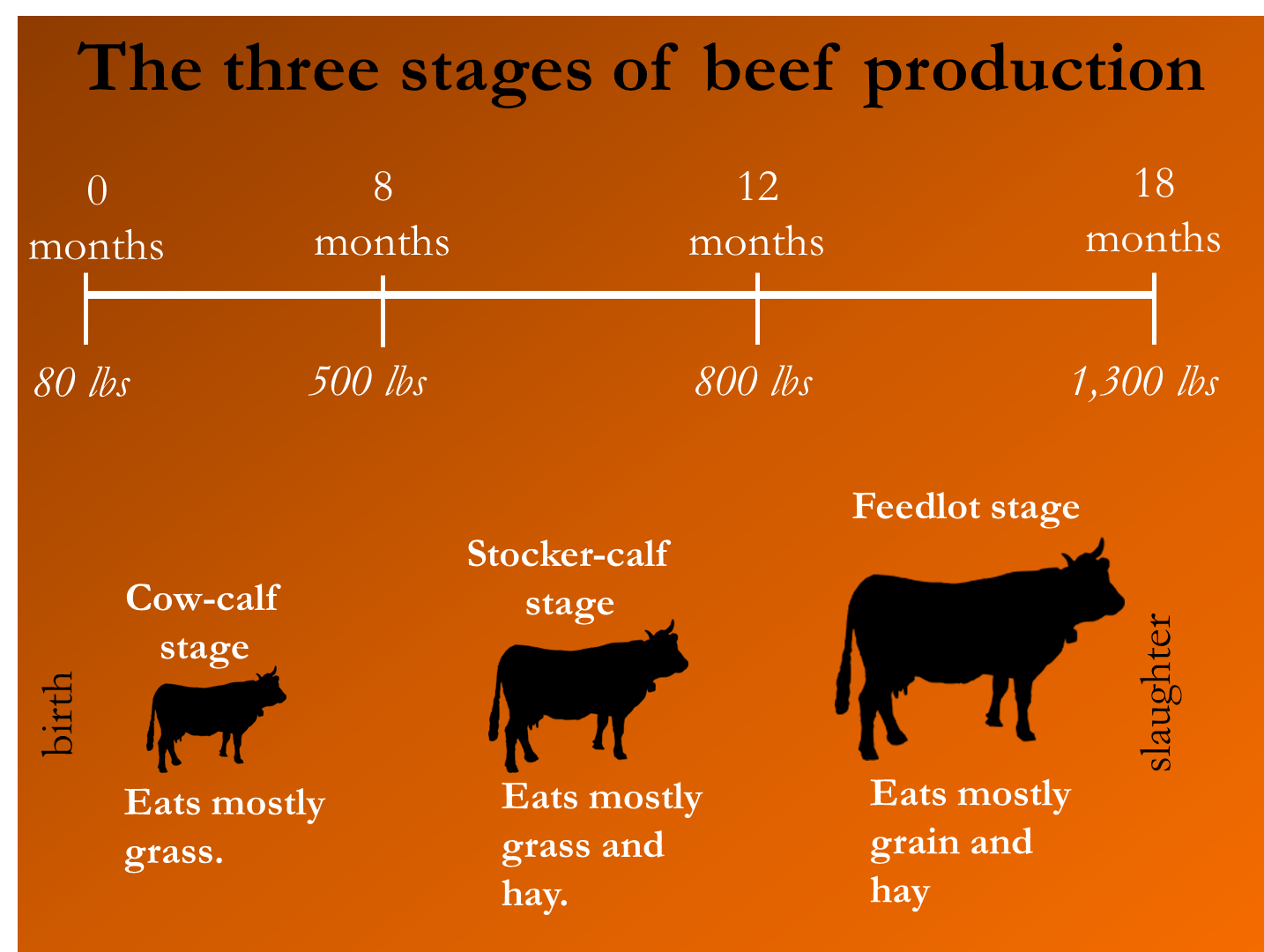
Figures
(1-3) DASNR Kitchen Sink at Oklahoma State University.
(4) Provided by and used with permission from the Noble Foundation.
(5) By H2O (own picture/copied from en:Image:Feedlot-1.JPG) [GFDL (http://www.gnu.org/copyleft/fdl.html) or CC-BY-SA-3.0 (http://creativecommons.org/licenses/by-sa/3.0/)], via Wikimedia Commons
(6) Original figure.